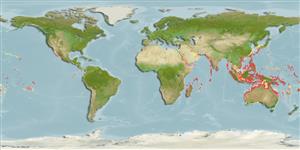Common names from other countries
>
Gobiiformes (Gobies) >
Gobiidae (Gobies) > Gobiinae
Etymology: Trimma: Greek, trimma, -atos = something crushed (Ref. 45335); macrophthalmus: Origin of name not given, but presumably from ‘macro’ for large and the Greek noun ‘opthalmos’, meaning eye; originally spelled as ‘macrophthalmus’, and the spelling is retained because the second half of the specific name is a noun; thus treated as noun in apposition..
Environment: milieu / climate zone / depth range / distribution range
Ecologia
marino associati a barriera corallina; distribuzione batimetrica 5 - 35 m (Ref. 90102). Tropical
Western Pacific: Cocos (Keeling) to Vietnam and Japan, south and east to the Great Barrier Reef, Fiji, and Samoa.
Size / Peso / Age
Maturity: Lm ? range ? - ? cm
Max length : 2.5 cm TL maschio/sesso non determinato; (Ref. 2798)
Short description
Chiavi di identificazione | Morfologia | Morfometria
Spine dorsali (totale) : 7; Raggi dorsali molli (totale) : 9 - 10; Spine anali: 1; Raggi anali molli: 8 - 9. Very similar to T. okinawae but lacks predorsal scales (Ref. 37816). Body with ctenoid scales except ventral midline and pectoral base with cycloid scales. Transverse scales 7-8. Mouth slightly oblique upwards. Second spine longest in 1st dorsal; rays of 2nd dorsal nearly equal; anal fin similar to 2nd dorsal; pectoral reaches to vertical of anus; pelvic fins without frenum but connected to basal membrane (Ref. 43541); characterized further by body with greyish matrix with dense red to orange spotting on head and body; median fins with faint yellow spotting; pair of large red spots on base of pectoral fin; longitudinal scale series 26-27; cheek and opercle without scales; depth of body 3.9-4.2 in TL (Ref. 90102).
Bottom-dweller of seaward reefs (Ref. 37816). Usually in small groups in caves and under ledges (Ref. 90102).
Life cycle and mating behavior
Maturities | Riproduzione | Spawnings | Egg(s) | Fecundities | Larve
Winterbottom, R., 2019. An illustrated key to the described valid species of Trimma (Teleostei: Gobiidae). J. Ocean Sci. Found. 34:1-61. (Ref. 121207)
IUCN Red List Status (Ref. 130435)
CITES (Ref. 128078)
Not Evaluated
Threat to humans
Harmless
Human uses
Strumenti
Special reports
Download XML
Fonti Internet
Estimates based on models
Preferred temperature (Ref.
115969): 24.1 - 28.8, mean 27.5 (based on 420 cells).
Phylogenetic diversity index (Ref.
82804): PD
50 = 0.5000 [Uniqueness, from 0.5 = low to 2.0 = high].
Bayesian length-weight: a=0.01023 (0.00477 - 0.02194), b=3.02 (2.84 - 3.20), in cm Total Length, based on LWR estimates for this (Sub)family-body shape (Ref.
93245).
Resilienza (Ref.
120179): Alto, tempo minimo di raddoppiamento della popolazione meno di 15 mesi (Preliminary K or Fecundity.).
Fishing Vulnerability (Ref.
59153): Low vulnerability (10 of 100).
